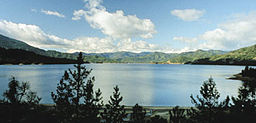Clear Creek (Sacramento River)
| Clear Creek | |
|
Whiskeytown Lake on Clear Creek
|
|
| Country | United States |
|---|---|
| State | California |
| Region | Shasta Trinity |
| Tributaries | |
| - right | Crystal Creek, Brandy Creek |
| Source | Damnation Peak |
| - location | Trinity Mountains, Shasta-Trinity National Forest |
| - elevation | 5,080 ft (1,548 m) |
| - coordinates | 40°57′31″N 122°31′45″W / 40.95861°N 122.52917°W |
| Mouth | Sacramento River |
| - location | Girvan |
| - elevation | 415 ft (126 m) |
| - coordinates | 40°30′20″N 122°22′04″W / 40.50556°N 122.36778°WCoordinates: 40°30′20″N 122°22′04″W / 40.50556°N 122.36778°W |
| Length | 60.6 mi (98 km) |
| Basin | 249 sq mi (645 km2) |
| Discharge | for French Gulch, above Whiskeytown Lake |
| - average | 211 cu ft/s (6 m3/s) |
| - max | 14,600 cu ft/s (413 m3/s) |
| - min | 2.07 cu ft/s (0 m3/s) |
Clear Creek (Ínaam in Karuk) is a tributary of the upper Sacramento River in northern California.
The creek is 60.6 miles (97.5 km) long, flowing in southern Siskiyou County and northern Shasta County. Clear Creek is the first major Sacramento River tributary downstream of the Shasta Dam.
Clear Creek originates in the Trinity Mountains, between Shasta Lake and Trinity Lake in the Shasta-Trinity National Forest, and flows into Whiskeytown Lake reservoir, impounded by Whiskeytown Dam. Past the reservoir, the stream bed continues south until its confluence with the Sacramento River. The Spring Creek Tunnel bypasses that section and delivers water from Whiskeytown Lake directly to Keswick Reservoir, both part of the Central Valley Project.
The site along Clear Creek where Pierson B. Reading discovered gold in 1848 was declared a California Historical Landmark.
...
Wikipedia

